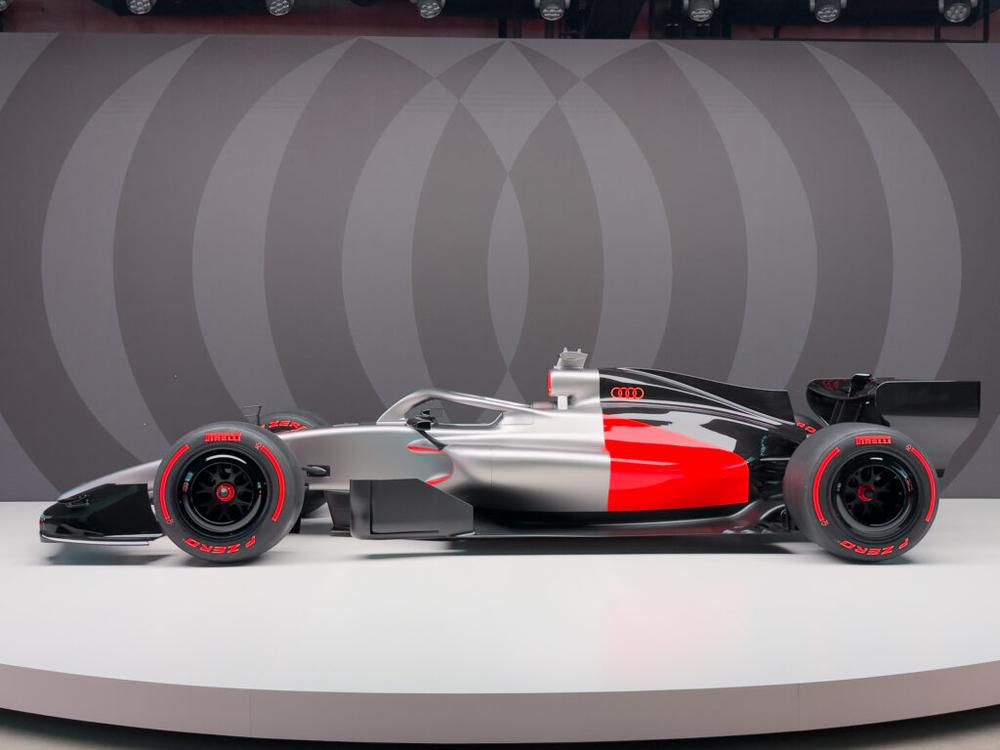MUNICH, Germany—Audi’s long-awaited Formula 1 team gave the world its first look at what the Audi R26 will look like when it takes to the track next year. Well, sort of—the car you see here is a generic show car for the 2026 aero regulations, but the livery you see, plus the sponsors’ logos, will race next year.
“By entering the pinnacle of motorsport, Audi is making a clear, ambitious statement. It is the next chapter in the company’s renewal. Formula 1 will be a catalyst for the change towards a leaner, faster, and more innovative Audi,” said Gernot Döllner, Audi’s CEO. “We are not entering Formula 1 just to be there. We want to win. At the same time, we know that you don’t become a top team in Formula 1 overnight. It takes time, perseverance, and tireless questioning of the status quo. By 2030, we want to fight for the World Championship title,” Döllner said.
I’ll admit, when I first saw the images Audi sent ahead of time, I was a little underwhelmed, but in person, as you approach it from different angles, it makes a lot more sense. The design is more than a little minimalist, juxtaposing straight-edged geometric blocks of color with the aerodynamically curved bodywork they adorn. The titanium references Audi’s latest concept car, and the red—which is almost fluorescent in person—is an all-new shade called Audi Red. It’s used to highlight the car’s various air intakes and looks really quite effective.
Why F1?
After a long and glorious history in sportscar racing and rallying before that, Audi’s motorsports activities virtually evaporated in the wake of dieselgate and then a brief Formula E program. Then in early 2022, Volkswagen Group revealed that after decades of “will they, won’t they” speculation, not one but two of its brands—Audi and Porsche—would be entering F1 in 2026. (The Porsche deal with Red Bull would later fall apart.)
The sport was already riding its post-COVID popularity surge, and a new technical ruleset for 2026 was written in large part to attract automakers like Audi, dropping one of the current hybrid energy recovery systems (the complex turbo-based MGU-H) in favor of a much more powerful electric motor (the MGU-K), and switching to synthetic fuels that must have at least 65 percent less carbon emissions than fossil fuels.
In August 2022, Audi confirmed a powertrain program that would be developed at its motorsports competence center in Neuberg, Germany. It also announced it was buying three-quarters of the Swiss-based Sauber team. The following year, then-Audi CTO and head of the F1 program Oliver Hoffman explained to Ars why the company was going to F1 now.
“Nearly 50 percent of the power will come out of the electric drive train. Especially for battery technology, thermal management, and also efficiency of the power electronics, there’s a clear focus. And together, the fit between Formula 1 and our RS technologies is [the] perfect fit for us,” Hoffman said at the time.
A team in trouble?
On track, things did not look great. The Sauber team had finished 2023 in 9th place, and 2024 was looking worse. (It eventually finished dead last with a miserable four points at the end of the year.) Rumors that Audi wanted out of the program had to be quashed, then in March 2024 Audi decided to buy all of Sauber, adding Andreas Seidl, formerly of McLaren and before that Porsche, to run the team, now called Audi Formula Racing.
But within a year, Hoffman was gone, together with Andreas Seidl. Replacing Hoffman as head of the Audi F1 project: Mattia Binotto, who saw Ferrari get close to but not quite land an F1 championship. Then in August, Jonathan Wheatley joined the team from Red Bull as the new team principal.
Binotto and Wheatley’s arrival seems to have unlocked something. At Silverstone, Nico Hülkenberg finished third, the first podium for the team since 2012 and the first ever for a driver that was long, long overdue. Hülkenberg now lies ninth in points. His rookie teammate Gabriel Bortoleto might have just had a disappointing home race, but last year’s F2 champ has shown plenty of speed in the Sauber this year. It will surely want to carry that momentum forward to 2026.
“The goal is clear: to fight for championships by 2030. That journey takes time, the right people, and a mindset of continuous improvement,” Binotto said. “Formula 1 is one of the most competitive environments. Becoming a champion is a journey of progress. Mistakes will happen, but learning from them is what drives transformation. That’s why we follow a three-phased approach: starting as a challenger with the ambition to grow, evolving into a competitor by daring the status quo and achieving first successes, and ultimately becoming a champion,” Binotto said.
What’s under the bodywork?
Technical details on the R26 remain scarce, for the same reason we haven’t seen the actual race car yet. Earlier today we visited Audi’s Neuberg facility, which is much expanded from the sportscar days—while those were also hybrid race cars, the state of the art has moved on in the near-decade since Audi left that sport, and F1 power units (the internal combustion engine, hybrid system, battery, but not the transmission) operate at a much higher level.
In addition to the workshops and cleanrooms where engineers and technicians develop and build the various components that go into the power units, there are extensive test and analysis facilities, able to examine parts both destructively (for example, cutting sections for a scanning electron microscope) and nondestructively (like X-raying or CT scanning).
Unlike in the LMP1 days of multiple Le Mans wins, actual on-track testing in F1 is highly restricted, limited now to just nine days over three tests before the start of the season. “When I think of my past LMP1 racing, we tested 50 days, 60 days, and if we had a problem, we just added the days. We went to Sebring or whatever,” said Stefan Dreyer, Audi Formula Racing’s CTO. “And this is also a huge challenge… moving into the future of Formula 1.”
For the first three years of the project, there was one goal: design and build a power unit for the 2026 regulations. The complete powertrain (the power unit plus the transmission) first ran a race simulation in 2024. In addition to Neuberg and Hinwil, Switzerland, where Sauber is based, there’s a new location in Bicester, England, part of that country’s “motorsports valley” and home to an awful lot of F1 suppliers and talent.
Now, the group in Neuberg has multiple overlapping jobs: assemble power units and supply them to the race team in Hinwil that is building the chassis, as well as begin development on the 2027 and 2028 iterations of the power units. It’s telling that all over the facility, video screens count down the remaining three months and however many days, hours, minutes, and seconds are left until the cars take to the track in anger in Australia.

 Scientists think they found a secret doorway in a 4,500-year-old Egyptian pyramid
Scientists think they found a secret doorway in a 4,500-year-old Egyptian pyramid